Effects on Intake Location on Water Quality
by G. Fred Lee and C. C. Harlin, Jr.

Because the quality of a water supply can often be translated directly into the cost of treatment, it is a matter of continuing concern to industry. Very little attention, however, has been given to how water intake location can affect the quality of water drawn from stratified lakes or reservoirs. In this article, the authors report their studies which show how variable depth intakes can produce better and/or more consistent water quality.
They also point up the possibilities of automation in selecting the best intake depth with varying lake stratification.
The need for greater quantities of water often requires that waters of poorer quality be selected as sources. In many cases, the only source of supply available is a relatively shallow lake or reservoir rich in the dissolved nutrients which promote algal growths. These types of water bodies are referred to as "eutrophic" lakes. The purpose of this paper is to review some of the characteristics of eutrophic waters that are of importance from a water quality standpoint, and to point out some of the factors that should be considered in the design and operation of intakes from these water sources. It is generally recognized that water quality varies with depth in lakes. In the case of eutrophic lakes the variation may be quite pronounced. The thermal stratification that occurs during the summer in many lakes may result in a two-layer system as shown in Figure 1. The upper layer of the lake or epilimnion, will be saturated or supersaturated in dissolved oxygen, have a higher temperature, large numbers of plankton organisms and low iron, manganese, and sulfide; while the lower layer, or hypolimnion, will have a lower temperature, low or no dissolved oxygen and plankton organisms, high iron, manganese. and/or sulfide. The zone separating these layers is the zone of rapid temperature change with depth and is called thermocline or mesolimnion. Studies have shown that each layer of a lake is not mixed and water quality varies markedly with depth and is highly variable in rime. It was found that a better raw water quality could be obtained by varying the depth than could be obtained by fixed depth water intakes.
Figure 1. Temperature stratification in a typical lake during summer.
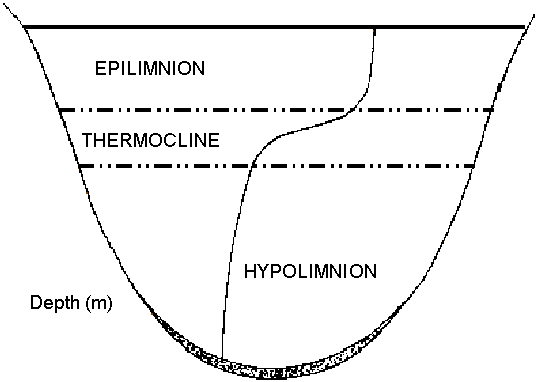
Basic Considerations
In the design of intake structures several criteria are considered. Some of these considerations are: adequate capacity, velocity limitation, location to minimize hazards due to debris and navigation, protection from problems due to ice, and the ability to take the best quality water. While most designers agree that the quality consideration is of utmost importance, too often it is not investigated to the degree that its importance should warrant. In most cases where water quality investigations have been made, these have been conducted to determine the effect of some known source of man-made pollution." (1) In these cases intake locations have been selected to minimize draft of the pollutant.
Often little or no consideration is given in intake design to the quality of water with respect to depth. There can be marked differences in water quality in lakes and impounding reservoirs. The changes in water quality of Lake Mead have been reported by Love (2). Weiss and Oglesby (3) have provided similar data for a North Carolina impoundment. The magnitude of these variations is dependent on the degree of eutrophication of the lake and season of the year. When intake structures are not designed to take into account these variations, it is impossible to select the best water at any given time. Also, many intakes are of the crib type which can take water only at a fixed depth." (4)
Lake Studies
Laboratory studies on the quality of the raw water obtained by the University of Wisconsin water supply have shown it to be highly variable. The intake is located about 600 feet off shore at a fixed depth of 10 feet. It was decided that an investigation would be conducted to determine the reasons for this variability. Lake Mendota, the source of the University of Wisconsin's supply, is a hard water eutrophic lake located near Madison, Wisconsin. The characteristics of this lake are presented in Figure 2.
Figure 2. Characteristics of Lake Mendota.
Physical |
|
Depth, feet-mean | 40 |
Depth, feet-maximum | 84 |
Cumulative drainage area, sq. mi. | 265 |
Volume, billion gallons | 126.4 |
Area of lake, sq. mi. | 15.2 |
Theoretical displacement period at 100 cfs - days | 1950 |
Lake frontage - miles | 21.0 |
Period of ice cover, average | December 19 - April 6 |
|
|
Chemical (major constituents) |
|
Alkalinity, total (CaCOa) | 142 mg/L |
Calcium (Ca) | 30 mg/L |
Magnesium (Mg) | 24 mg/L |
Sulfate | 17 mg/L |
Chloride | 5 mg/L |
Studies Show That Variable Depth Intakes Can Draw
Better Water from Stratified Lakes
The water chemistry research vessel, Kekule, was used for this investigation. The Kekule is a 30-foot motor launch equipped as a laboratory for lake research. An automatic sampling and analytical system was installed on the boat. Samples were obtained by a submersible pump lowered through a 10-inch diameter sampling well located amidship Water was pumped from the desired depth through a series of instruments for continuous automatic analysis of turbidity, pH, temperature, dissolved oxygen and conductance. In addition, samples were collected for land laboratory chemical analysis, plankton identification, and enumeration. The sampling and analytical system is shown in Figure 3.
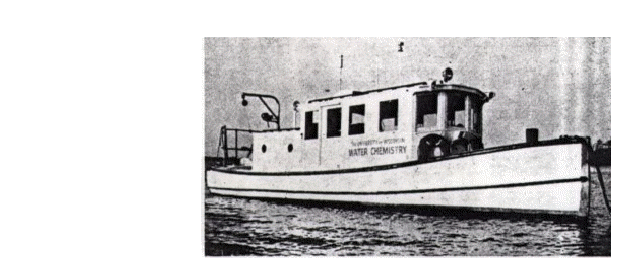
Figure 3. - Sampling and automatic analysis system used on the water chemistry research vessel, Kekule.
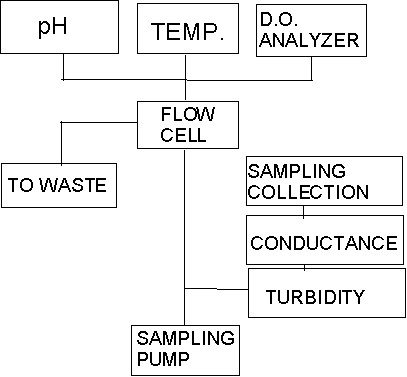
The Kekule was also equipped to measure wind velocity and direction, solar energy, and air temperature. All other analyses were performed in accord with procedures in Standard Methods.(6) The sampling procedure was as follows: The Kekule was anchored at the desired position, sextant readings were taken on shore stations, the pump was lowered through the sampling well to the desired position and after a two minute flushing period, readings were taken from each instrument. Simultaneously samples were collected for future analysis. The pump would be lowered to a new depth and the above procedure repeated. This sampling and analytical procedure enabled the collection of much more data than normally obtained in grab sampling procedures with a result that a much better picture was obtained on quality of lake water.
Analytical Results
During the spring, summer, and fall of 1963 and 1964 a series of cruises was made in which the variation in water quality was determined at various locations and depths. Typical results from these cruises for a single station are presented in Figures 4 and 5. The general characteristics of the data obtained on this cruise are discussed below.
Examination of Figure 4 shows that this lake can be represented as a two layer system in which temperature ranges vary from 24.50C at the surface to 14.5C at the bottom. Cruises on other days have shown that the position of the thermocline gradually deepens from near the surface at the onset of stratification in the spring to near the bottom at fall overturn. Careful examination of the temperature in the epilimnion shows that this layer is not isothermal. Small changes in temperature are observed with depth.
Figure 4
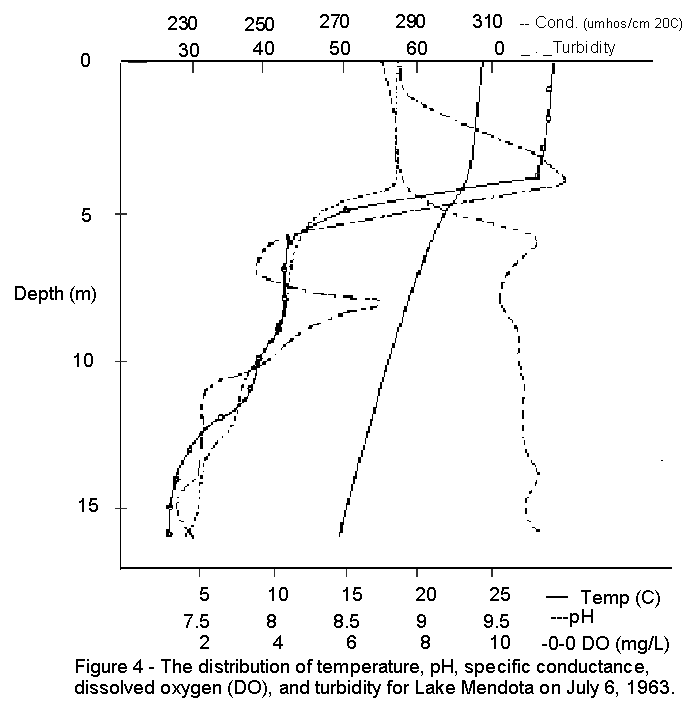
These small temperature changes will be shown to be of importance in drawing water from a specific depth.
The changes in specific conductance with depth are believed to be due to photosynthetic precipitation of calcium carbonate. Studies have shown that Lake Mendota water is saturated with calcium carbonate. During periods of high photosynthetic activity in the first few meters of water, the pH of this water is raised, resulting in an increase in carbonate. The excess carbonate precipitates with calcium to form calcium carbonate. The increase in specific conductance at and below the thermocline is believed to be due to the dissolution of precipitated calcium carbonate as it settles in the water and by dissolution from the sediments. The increased solubility of calcium carbonate at the thermocline is due to decreased temperature and pH. From a water quality point of view, this could mean that there is a slight but probably insignificant increase in hardness in the lower parts of the lake.
The oxygen and pH profiles in the epilimnion reflect the photosynthetic activity of the phytoplankton. The decrease in oxygen and pH below 4-5 meters is usually associated with reduced light penetration to this depth. The reduced or absent oxygen and reduced pH below the thermocline is normally associated with the biochemical and chemical oxygen demand of the water, detritus and sediments. The changes in oxygen and pH with depth are of minor significance in terms of water quality provided that the water is taken above the thermocline. Associated with the deoxygenation of the hypolimnion, various studies have shown that this water contains significant amounts of sulfide, iron and manganese.
The single most important characteristic affecting water quality measured in this study is the turbidity. Turbidity or light scattering properties of the water is related to the total particulate matter in the water. For Lake Mendota, the particulate matter consists of living and dead plankton organisms and aggregates of organic compounds. Examination of Figure 5 shows that marked changes in organisms are observed with depth. In general, it can be seen that the particulate matter tends to accumulate in certain layers. It was also noted that in some instances a greater number of one type of algae will be found at one depth. Since it is well known that certain organisms are more difficult to remove by treatment than others, it may be possible to select a layer for the water intake to obtain a water with a minimum of particulate matter and more easily removed organisms.
It should be pointed out that during periods of spring and fall overturn when the lake is essentially isothermal, marked organism stratification is still apparent.
Variability of Water Quality
Highly variable raw water quality requires continuous adjustment in chemical doses to produce a suitable finished water quality. Ideally, therefore, raw water quality should remain reasonably constant. The changes in composition of lake water with depth also occur with time. In general, the amount of stratification observed for dissolved and particulate matter in the epilimnion of a lake is related to wind velocity (direction and duration), air and lake temperatures, sunlight, time of day, season of year, type of organism, size and shape of lake, and many other factors. Unfortunately, it is difficult, if not impossible, to predict the interrelationship between these factors and water quality. Many of the relationships are discussed in the limnological and oceanographic literature.
Usually, a water plant operator will learn some of these relationships and will know, for example, that a wind from a certain direction at a certain time during the year will result in raw water with a certain range of quality. In the future, automatic analytical instrumentation such as used in this investigation will enable the operator to select the best water quality and, therefore, eliminate some of the variability in raw water quality
Based on the data collected on Lake Mendota, the changes in water quality with time at one depth are reasonably constant for periods in the order of a few hours to a few days. As previously discussed, on certain cruises the turbidity at any one depth was highly variable. On one cruise, it was observed that at a depth of 8 meters, the dissolved oxygen varied from 5 - 12 mg/L in a period of less than 20 seconds. Large changes were also observed in turbidity at this depth. The temperature of the water was constant within 0.10C. The instrument readings at 7 and 9 meters were constant. The variability at the 8 meter depth are believed to be due to a thin layer of photosynthetic organisms that vary in depth in a wave-like manner. Since these variations are isothermal, it is believed that these waves are reflections of the internal progressive waves associated with the thermocline.
These rapid fluctuations in water quality were usually associated with winds above 15-20 mph. In general, since this variability is of relatively high frequency, much of this variability would be lost in the intake works and pipe line. Therefore, rapid fluctuations are of little importance in water quality.
Under certain conditions, the internal progressive and standing waves associated with the thermocline are of such period as to be of concern in water quality. Mortimer (6) has shown that when the water supply intake is located at the thermocline, marked periodic changes occur In temperature of the water. Variations in temperature observed in the studies of Mortimer would be of importance in terms of water treatment since these changes would require continuous adjustment of chemical doses to achieve uniform finished water quality, at a minimum of cost. This type of variability would only be associated with unproductive oligotrophic lakes, since productive eutrophic lakes such as Lake Mendota would result in periodic draft of oxygen free water and, therefore, intake at the thermocline would be an unsuitable location.
Mention should be made about the quality of water often associated with the surface layer of the lake. Examination of Figure 4 shows that the surface meter of water in Lake Mendota is often of lower turbidity than the water immediately below. This observation might lead some to believe that consideration should be given to intake location at this depth. However, in general, the surface layer should be avoided since this layer often has large amounts of floating debris, algal scum, and therefore, may be of poor quality. Intakes should be located at sufficient elevation above the bottom and away from the shore so that winds that stir up bottom sediments do not produce turbidity.
Locating Intakes
Unfortunately, many of the desirable characteristics of a eutrophic lake do not occur at the same depth. Often the operator must compromise in raw water quality. From one point of view, the water below the thermocline would be selected. However, the hypolimnion of a eutrophic lake is oxygen free and may contain iron, manganese, and/or sulfide. These constituents make it necessary to take the warmer more turbid waters of the epilimnion as a source of supply during late summer. However, water may be taken below the thermocline during early summer since the hypolimnion still contains some dissolved oxygen.
One of the primary factors determining water quality In the epilimnion of a eutrophic lake is the plankton. In this study it has been shown that marked changes in the plankton populations occur with depth. Further studies are being conducted on the changes in other factors that may affect water quality. These studies include variations in tastes and odors, chlorine demand, and filterability with depth. These results will be presented in a future paper. This paper considers turbid waters as the characteristic of the water that determines the level of water draft.
It is apparent upon examination of the data presented in Figures 4 and 5 that the water plant operator may select a water with a minimum of turbidity and plankton organisms by setting the level of water draft at a certain depth. In general, for a given period there is a certain intake setting that will result in the best water quality.
Figure 5
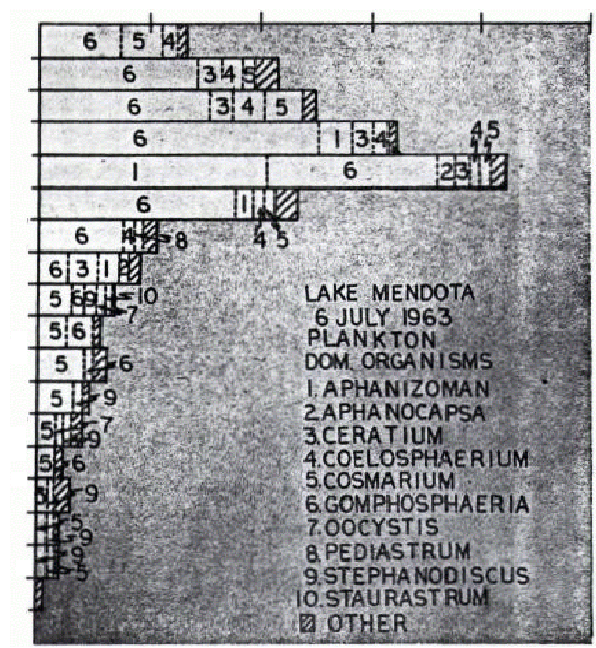
One of the first questions that would be asked is the feasibility of drawing water at specific depth. For years engineers have designed inlet structures with multiple openings for the purpose of taking water at different depths. The number of openings has often been limited, thus restricting the degree of selectivity, it is obvious that the more openings provided at different depths, the better control of the water withdrawn.
The flow pattern into an inlet in an isothermal fluid can be predicted to a high degree of accuracy. Under this condition the water entering an inlet would consist of a mixture of water coming from various depths in the water mass. The selection of water from a particular depth is, therefore, impossible. Fortunately, the epilimnion of a lake is not isothermal and as a result a small amount of density stratification exists. Debler has studied the discharge of a stratified fluid into a line sink and found that the flow pattern consists of an upper, essentially stagnant region, and a lower region in which the entire discharge is concentrated.
As applied to a water intake structure, this density stratification would tend to minimize the intake of less desirable water above and below a layer of better quality waters, if the intake were designed to select from the optimum depth. The flow net under this condition would be dependent on the degree of thermal stratification. While stratification in lakes and reservoirs is most commonly associated with temperature difference, the same conditions with respect to flow characteristics would prevail, if stratification were due to density variations caused by chemical or turbidity variations. The reader is referred to a report by the Tennessee Valley Authority and the U. S. Corps of Engineers for an expanded discussion of this topic.
The Outlook on Intake Design
There is an increasing tendency toward automation in water treatment. One of the areas of water treatment that offers the possibility of automation is the water intake. Automatic turbidimeters, etc as used in this investigation, could be used to determine water quality and also to automatically adjust the intake to the desired level. Instrumentation described by Weiss and Oglesby (9) for monitoring other parameters such as temperature and dissolved oxygen could also be applicable
At small plants or locations where changes in water quality do not occur frequently, changes in intake depth could be made manually, based on a continuous or intermittent monitoring of water quality. In larger plants, or where rapid and frequent changes occur, consideration could he given to automatic adjustment of intake depth in response to changes in quality. Some possible designs for accomplishing this change in depth might include multiple ports which would be opened or closed by automatically controlled valves, or a telescoping inlet where height would be adjusted automatically to the desired depth. The justification for the expense of such an installation would have to be based on savings in treatment costs resulting from a more uniform quality raw water.
ACKNOWLEDGMENT
This Investigation was supported in part by the PHS training grant number ST1-WP-22-02, Division of Water Supply and Pollution Control, Public Health Service, and Geophysics Branch, Office of Naval Research The use of the facilities of the Laboratory of Limnology and the assistance of H. Rai is greatly appreciated.
REFERENCES
1. Coughlan, F. P., "Locating the New Intake." Jour. AWWA, 50:668 (1958).
2. Love, S. K, "Relationship of Impoundment to Water Quality." Jour. AWWA. 53559 (1961).
3. Weiss, C M. and Oglesby, R. T., "Limnological Aspects of Impounded Water Supplies with Reference to Raw Water Quality." Public Works, 91:97 (Jul. 1960).
4. Burdick, C. B., ~'Water Works Intakes." Jour. AWV,JA, 38:315 (1946).
S. "Standard Methods for the Examination of Water and Wastewater" APHA. AWWA, and WPCF, New York. 11th Ed., (1960).
6. Mortimer, C. H., "Frontiers in Physical Limnology with Particular Reference to Long Waves in Rotating Basins." Public No. 10, Great Lakes Research Division, Univ. of Michigan, 9 (1963).
7. Debler, W. R, "Stratified Flow into a Line Sink." Trans. ASCE 12C (Part I): 491 (1961).
8. Tennessee Valley Authority and the U. S Corps of Engineers." Internal Density Currents Created by Withdrawal from a Stratified Reservoir." Norris, Tennessee (1962).
9. Weiss, C. NI. and Oglesby, R. T., "Instrumentation for Monitoring Water Quality in Reservoirs Jour. AWWA, 55.1213 (1963)

G. Fred Lee is Associate Professor of Water Chemistry at the University of Wisconsin. In his position, he also serves as Director of the Water Chemistry Program at the University. He holds a B.A. degree from San Jose State College, an M.S. in Public Health from the University of North Carolina, and a Ph.D in water chemistry from Harvard University. Prior to his work at Wisconsin, Dr. Lee served as Assistant Professor of Water Chemistry at the University of Pittsburgh.
Curtis C. Harlin, Jr. serves with the Research Branch, U.S. Public Health Service, Robert S. Kerr Water Research Center, in Ada, Oklahoma. While engaged in the research reported in this article, he was an associate of Dr. Lees at the University of Wisconsin. His training includes a B.S. in Civil Engineering and an M.S. in Sanitary Engineering from Texas A & M College, and a Sc.D from Washington University.

Reference as: "Lee, G.F. and Harlin, C.C., 'Effect of Intake Location on Water Quality,' Industrial Water Engineering 2:36-40 (1965)."

|